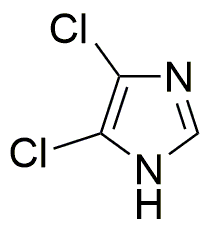4,5-Dichloroimidazole is widely utilized in research focused on:
- Pharmaceutical Development: This compound serves as an important intermediate in the synthesis of various pharmaceuticals, particularly in the development of antifungal agents. Its unique structure allows for modifications that enhance drug efficacy.
- Agricultural Chemicals: It is used in the formulation of agrochemicals, including fungicides and herbicides, providing effective solutions for crop protection. Its application helps in improving yield and managing plant diseases.
- Biochemical Research: Researchers utilize 4,5-Dichloroimidazole in studies related to enzyme inhibition, particularly in understanding metabolic pathways. This can lead to insights into disease mechanisms and potential therapeutic targets.
- Material Science: The compound is explored in the development of new materials, particularly in coatings and polymers, due to its chemical stability and resistance to degradation, enhancing the durability of products.
- Analytical Chemistry: It is employed as a reagent in various analytical techniques, aiding in the detection and quantification of other compounds. This application is crucial for quality control in laboratories and manufacturing processes.
General Information
Properties
Safety and Regulations
Applications
4,5-Dichloroimidazole is widely utilized in research focused on:
- Pharmaceutical Development: This compound serves as an important intermediate in the synthesis of various pharmaceuticals, particularly in the development of antifungal agents. Its unique structure allows for modifications that enhance drug efficacy.
- Agricultural Chemicals: It is used in the formulation of agrochemicals, including fungicides and herbicides, providing effective solutions for crop protection. Its application helps in improving yield and managing plant diseases.
- Biochemical Research: Researchers utilize 4,5-Dichloroimidazole in studies related to enzyme inhibition, particularly in understanding metabolic pathways. This can lead to insights into disease mechanisms and potential therapeutic targets.
- Material Science: The compound is explored in the development of new materials, particularly in coatings and polymers, due to its chemical stability and resistance to degradation, enhancing the durability of products.
- Analytical Chemistry: It is employed as a reagent in various analytical techniques, aiding in the detection and quantification of other compounds. This application is crucial for quality control in laboratories and manufacturing processes.
Documents
Safety Data Sheets (SDS)
The SDS provides comprehensive safety information on handling, storage, and disposal of the product.
Product Specification (PS)
The PS provides a comprehensive breakdown of the product’s properties, including chemical composition, physical state, purity, and storage requirements. It also details acceptable quality ranges and the product's intended applications.
Certificates of Analysis (COA)
Search for Certificates of Analysis (COA) by entering the products Lot Number. Lot and Batch Numbers can be found on a product’s label following the words ‘Lot’ or ‘Batch’.
*Catalog Number
*Lot Number
Certificates Of Origin (COO)
This COO confirms the country where the product was manufactured, and also details the materials and components used in it and whether it is derived from natural, synthetic, or other specific sources. This certificate may be required for customs, trade, and regulatory compliance.
*Catalog Number
*Lot Number
Safety Data Sheets (SDS)
The SDS provides comprehensive safety information on handling, storage, and disposal of the product.
DownloadProduct Specification (PS)
The PS provides a comprehensive breakdown of the product’s properties, including chemical composition, physical state, purity, and storage requirements. It also details acceptable quality ranges and the product's intended applications.
DownloadCertificates of Analysis (COA)
Search for Certificates of Analysis (COA) by entering the products Lot Number. Lot and Batch Numbers can be found on a product’s label following the words ‘Lot’ or ‘Batch’.
*Catalog Number
*Lot Number
Certificates Of Origin (COO)
This COO confirms the country where the product was manufactured, and also details the materials and components used in it and whether it is derived from natural, synthetic, or other specific sources. This certificate may be required for customs, trade, and regulatory compliance.


